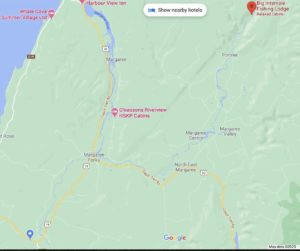© 2020 Donna Hébert, all rights reserved.
The longest so far, this slideshow has 52 images and the music (4:40) is the Québecois waltz via Jean Carignan and Willy Ringuette, “La Valse Joyeuse,” from my 2009 In Full Bloom CD. I play this with pianist Rachel Aucoin and button accordionist Sabin Jacques. https://youtu.be/Utdp-MbA1Ew
Margaree is almost a generic term here. “Where do you live,” people ask, and I have to think a moment. “Southwest Margaree,” I answer. But it’s not that simple. We’re on the West Side of Southwest Margaree and it took me awhile to figure out that’s what WSSW Margaree meant on the road sign. There’s an East Side of Southwest as well, on the opposite side of, you guessed it, the Margaree River. But just which Margaree River am I referring to? Technically, there are three of them!
Bob has been taking me around the Margarees, their collective name, for several years. There seemed to be a lot of them, though I knew his home was in Southwest Margaree. There are actually nine Margarees. I looked them up. Only one of them, Upper Margaree, is on “upper” part of the Southwest Margaree River, which, despite the name, is the farthest south of all the other Margarees, as the SW Margaree River flows northeast out of Lake Ainslee toward Margaree Forks, where it joins with the Northeast Margaree to become the Margaree River, flowing toward Margaree Harbour and emptying into the Gulf of St. Lawrence. All the other Margaree villages are situated along the Northeast Margaree River. Got that? It might just be easier to explain that a river runs through it every which way. Or show you a map . . .
Today, we got into the woods a little more, grabbed sandwiches at The Dancing Goat in Northeast Margaree, and headed toward Big Intervale, source of the NE Margaree River, from the blue dot on the lower left to the red dot in the upper right of the map, following the river/s. The road turns to gravel quickly when you leave the Cabot Trail, but we’ve seen a lot worse. Nice and wide, it narrows at the end, following the river, where it ends at Big Intervale Fishing Lodge. Everyone is obliged to turn around in the lodge’s front yard to go back where they came from.
There was one way in and the same way back, yet it looked different and I noticed little things that I’d missed on the way in, like the fact that they didn’t bury the wires and the trees are pretty thick so anyone who lives there in any season must be equipped with a generator. I also got to thinking about how much simpler the homes were than the glassy showplaces on the ocean bluffs. It’s a whole other island up in the woods. Don’t forget your rod, your reel, and your bug suit. You can fish with a license along the river as long as you can find a safe place to park and you can keep the trout you catch, but the salmon are catch and release.
We stopped at every bridge to examine the waters that go into making a river, noticing many fingerling trout in the shallows (salmon hide in the deeper pools), and we looked around many country corners. The light was quixotic, with cloud cover moving away quickly and the sun blazing through, only to hide a moment later. There was something new around every bend in the road.
